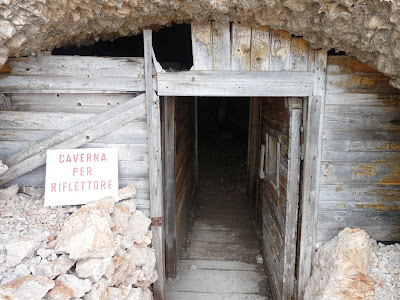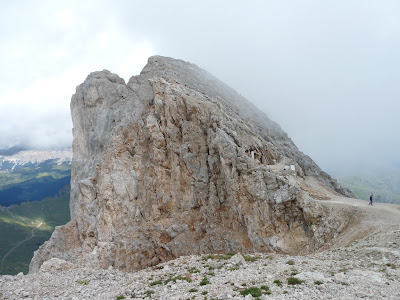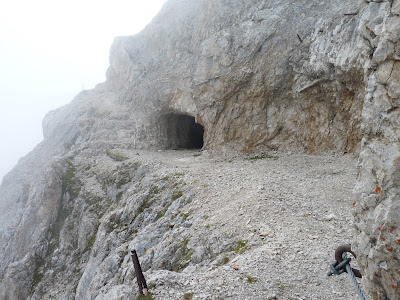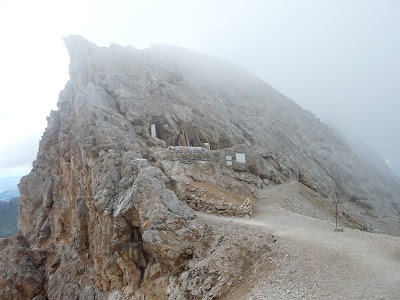Peaking at 3,343 meters (1o,967 ft), the Marmolada, with its majestic
appearance, well earns its name of “Queen of the Dolomites”. The highest
mountain of the Dolomites, Marmolada is also characterized by the only large
glacier in these mountains.
Before World War I, the border between Italy and Austria-Hungary ran
through the mountain, which thus became a battlefield.
Italian forces held the rocky southern side of the Marmolada, while
Austro-Hungarian troops held the northern side with its glacier. In the beginning,
nobody thought it would be possible to maintain a permanent garrison on the
summit; Austrian patrols, and in one instance also Alpini Lieutenant Barlese
with guide Fermo Chenet, sometimes ventured till the peak, which was later
secured by Austro-Hungarian forces. Austro-Hungarian outposts were also created
on the rocky spurs called Col dei Busc, Sasso delle Undici and Sasso delle
Dodici, as well as on Punta Rocca (3,259 m), where they placed a gun. These
positions were supplied by a series of cableways that started in the Gardena
Valley.
While Marmolada saw no important activity in 1915, during 1916 Italian
forces started attacking Punta Serauta (3,069 m), Serauta Pass (Forcella
Serauta, 2,880 m) and Point 3065 (meters) in an attempt to gain a foothold on
the glacier.
On 8 April 1916, an Alpini platoon of the Val Cordevole Battalion
captured the ridge between Serauta Pass and Point 3065; the Austro-Hungarian
troops withdrew to nearby Forcella V, and five days later, with artillery
support, they recaptured the ridge. Two days passed, then a patrol of the 51st
Infantry Regiment (Alpi Brigade) climbed the Antermoia Valley and recaptured
Forcella Serauta. These men, however, were infantrymen, lacking both mountain
equipment and experience, and they were not able to hold the position. On 17
April a new Italian attack failed, but on 30 April, following a plan devised by
Captain Menotti Garibaldi of the 51st Infantry Regiment (grandson of
Giuseppe Garibaldi), they captured Forcella Serauta once again. On 2 May, Point
3065 was also captured by Italian forces. This time the Italians permanently
occupied these positions, along with Punta Serauta.
From there, they could fire with guns and machine guns on anything that
moved on the glacier; Austro-Hungarian bearers were cut down before reaching
the position where they were headed, and movement became only possible in foggy
days or with bad weather (which reduced the risk of being killed by Italian
fire, but increased the risk of being killed by the mountain), as the Italians
had placed on Serauta even three spotlights, to light up the glacier at night.
Austro-Hungarian losses kept increasing, and their situation soon became
unbearable; if they would not find a way to supply their strongholds without
being fired on, they would soon have to abandon all the positions on the upper
side of the glacier.
Starting in May 1916, the Austrian engineer Leo Handl designed and
created a “city of ice” below the glacier; over twelve kilometers of galleries
were dug in the ice, 40 meters below the surface of the glacier, linking all
Austro-Hungarian positions. This city below the glacier included depots,
accommodation for 250 men, kitchen, mess rooms, two coffees, infirmaries,
privys, machinery rooms, a forge and even a chapel, all dug in the ice; the
Austro-Hungarian garrison could thus be sheltered from Italian fire, and one
could move from one position to another without risk of being hit. In March
1917, the “city” was even provided with electric lighting. At times, Italians
broke into some galleries, resulting in short hand-to-hand fights in the depths
of the glacier, “like cavemen”.
However, more Austro-Hungarian depots and barracks, forming entire
villages, were built above the glacier, further down the mountain, outside of
the Italian gun’s range. One of these villages of huts and depots, the Gran
Poz, became known for one of the greatest natural disasters of the war: on 12
December 1916, when a period of heavy snowfall was followed by a sudden warming
and rain, a huge avalanche (150,000 tons of snow) detached from the glacier and
wiped away the entire village; of the 321 men who were there, 270 lost their
lives. The last survivors were found five days later. One hut was later found a
kilometer away from where it was, along with its occupants. Handl had foreseen
the risk of such a disaster, and proposed to move the depots to the “city of
ice”, but his suggestion had been refused for tactical reasons.
In the whole Marmolada group, thousands men on both sides were killed by
avalanches, more than those killed in actual fighting.
Another contended pass was Forcella Marmolada (2,910 m). Left alone in
the early months of war, the Austro-Hungarian commands decided to occupy it in
Autumn 1915, after the finding of an Italian beret and cartridge case. This was
done in January 1916 by Kaiserjäger led by Cadet Officer Ludescher; when they
reached the pass, they found out that they had preceded the Italians by a mere
few minutes, as an Alpini company of the Valde Cordevole Battalion (under Captain
Arturo Andreoletti, whom in peacetime had made the eighth ascent of the
southern side of Marmolada), coming from the other side of the mountain, was
climbing 30 meters below. The Alpini had to retreat. Later on, an Alpini patrol
climbed a vertical canyon that led to a position about 50 meters above Forcella
Marmolada, but they were also repelled at last minute. The Austro-Hungarians
then built a hut for a 50-man garrison on the pass.
More fighting involved the Forcella V, a deep crack in the southern face
of the Marmolada, between Point 3065 and Point 3135. Its control by the
Austro-Hungarians prevented the Italians from accessing the glacier; this
position, defending the two main peaks of Marmolada (Punta Rocca and Punta
Penia) was fortified with two overlapping caverns, linked to the “city of ice”.
On 17 June 1916, an Italian attack was repelled by Austro-Hungarian
artillery using gas shells.
On 4 July 1917, the Italians started to dig a 250-meter long tunnel
that, starting from the east side of Point 3065, would lead to Forcella V. On
20 July an Italian platoon (fifteen men led by Lieutenant Flavio Rosso),
expressly created for this task and armed with submachine guns and
flamethrowers, captured the lower cavern after fierce hand-to-hand combat; they
planned to place a mine inside the cavern and blow it up, in order to destroy
the other one, which was located directly above it, and was still in
Austro-Hungarian hands. Before this was possible, however, Austrian soldiers,
under Lieutenant Julius Pleichinger, realized the Italian plane and placed a
mine of their own; the Austrian mine exploded first, on 26 September 1917,
burying Lieutenant Rosso and all his men under the shattered rocks. Their
bodies were never recovered.
Despite the loss of the platoon, Italian artillery fire eventually
forced the Austro-Hungarian garrison to abandon the position; Forcella V thus
fell in Italian hands. The next objective for the Italians was Point 3,153,
which the Austro-Hungarians had turned into a stronghold. Frontal assault
proved to be impossible, but the only other way was to climb a 500-meter
vertical face (V-VI grade difficulty). The Italian commands even planned a
surprise attack where an aerostat would land special alpine troops on the
glacier, but this was never carried out. On 28 October 1917, instead, eight
Alpini of the 206th Company, led by Sergeant Giacomo D’Osbel, passed
through an opening of the gallery that led to Forcella V, climbed down below the
pass, then climbed a rocky tower that led to Point 3,153 and took the small
Austro-Hungarian garrison by surprise. After a short fight, the
Austro-Hungarians surrendered, and Point 3153 was thus captured by the
Italians.
All was for nothing, however, as just a few days later, on 4 November,
all Italian forces on the Marmolada were ordered to abandon their position: the
Austro-Hungarian and German forces had broken the Italian lines at Caporetto,
and the troops in the Dolomites had to whitdraw to Mount Grappa and the Piave
River, after burning their huts to prevent them from being captured intact.
 |
| The glacier near Punta Rocca. |
 |
| Italian 75/27 mm Mod. 1911 gun. |
 |
| A memorial stone remembering the fifteen men killed by the Austrian mine at Forcella V on 26 September 1917. |
 |
| Remains of positions near Punta Rocca. |
 |
| Plaques summarizing the war on Marmolada and remembering the restoration work undertaken in the 1970s. |
 |
| "1915-1918 - The Austrian and Italian fallen. The war divided them, remembrance unites them". |
 |
| Guard post in a cave. |
 |
| Here was a hut; now only the foundations are left. |
 |
| Reconstructed hut. |
 |
| The few surviving boards of another hut. |
 |
| Guard post and small shelter. |
 |
| Reconstructed shelter in a cave. |
 |
| Trench shield. |
 |
| Some barbed wire survives to this day. |
 |
| "51st Infantry Regiment, 3rd Platoon" |
 |
| Concrete positions. |
 |
| Barbed wire. |
 |
| Housing for spotlight. |
 |
| The glacier as seen from the positions; during WWI it was much larger, spreading till the base of the rocks on the right of the photo. |










































































No comments:
Post a Comment